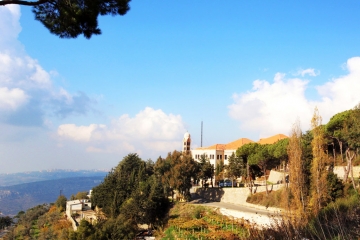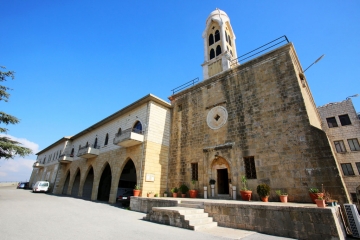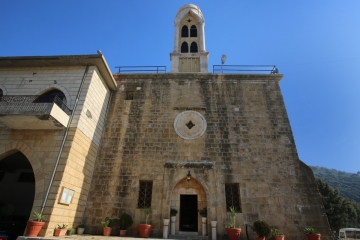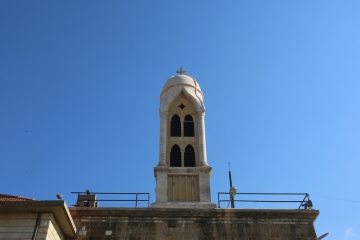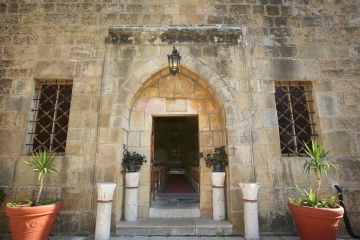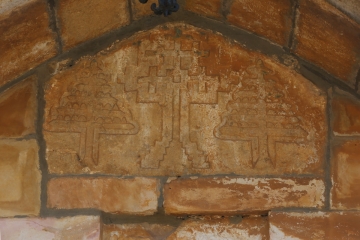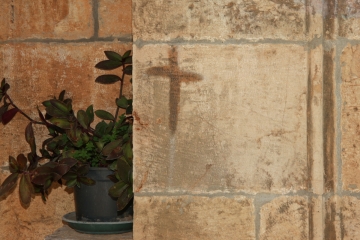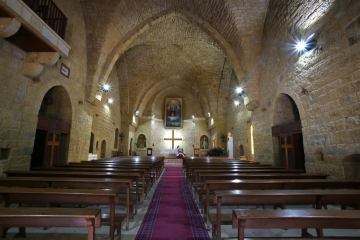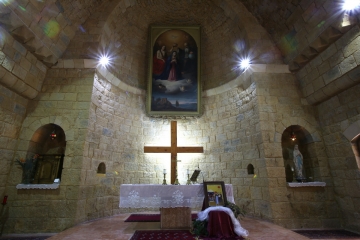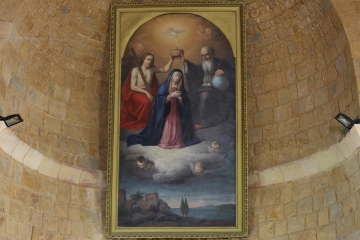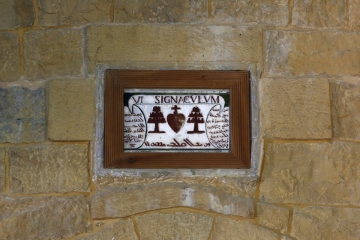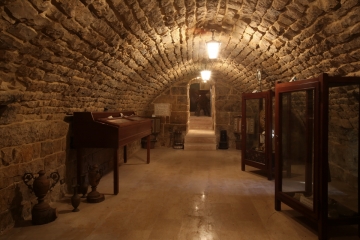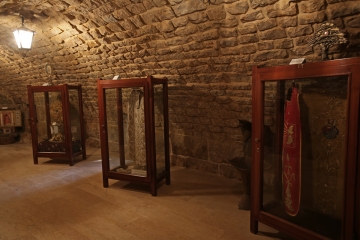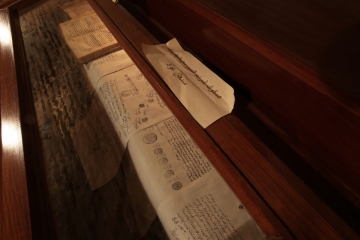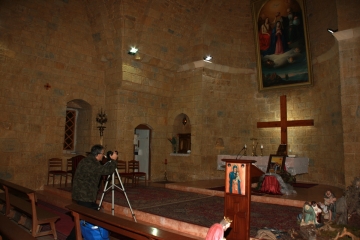دير سيّدة مشموشة – جزّين
يَقوم هذا الدير بِجوار قرية مَشموشِة التابعة قضاء جزّين.. في سَفح جبل النبي "ميشا"، ويُطِلّ على القرى المُجاورة : مَشموشِة وبكاسين وصبّاح وبتدّين اللقش والميدان. وكلمة مَشموشِة، حَسَب تفسير الدكتور سعيد فريحة في كتابه "مُعجم أسماء المُدن والقرى اللبنانية"، تَحريف لكلمة سِريانية هي "مِشمَّساني" التي تعني شَمامِسَة وخُدّام الكنيسة.
وقد أُنشِىء هذا الدير بقرار من الرهبانية اللبنانية المارونية في عَهد رئيسها العامّ الأباتي توما اللبّودي في العام 1736.. على قطعة أرضٍ اشترتها من البطريرك سِمعان عواد عندما كان لا يزال أسقفاً، وهو ابن تلك المنطقة الجنوبية من بَلدة الميدان في قضاء جزّين، وقد ضَمَّت كنيسة الدير لاحقاً جُثمانه بعد وفاته في العام 1756 اعترافاً بفَضلِه ووفاءً له، وهو الذي أصبح هذا الدير مقرّاً بطريركياً بفضل إقامته فيه.
ولم تشأ الرهبانية ان يظَلّ ديرها هذا وحيداً أعزل في ذلك المحيط، فاشترت له أملاكاً، وأضافت إليه، سنة 1741، كنيسةً فخمة، فكان أول دير لهذه الرهبانية في تلك المَنطقة، وكان إذ ذاك يُسمّى "دير سيّدة الشوف".
ثم توالت على هذا الدير كوارث طبيعية وبشرية، فبَعدَ حوالي رُبع قرن من إنشائه صدَّع زِلزال كنيسته، فجُدِّد بناؤها بين سنتَي 1761 و 1763، فأصبحت، بعد إعادة رَونقِها القديم اليها، من أجمل الكنائس بتألَّقُ بَهائها ورَوعَة هندستها. وواصلت الرهبانية إداء رسالتها في هذا الدير وجواره إلى أن فاجأتها أحداث العام 1840، فأُحرِق الدير وقضى شهيداً ستة من رهبانه. ولمّا كانت عَملية تَرميم الدير وإصلاحه تُكلِّف أموالاً طائلة، لَم يَعٌد للدير ومدرسته مَجال لتحصيلها، وقد تَعَطَّل كِلاهُما عن العمل، أوفدت الرهبانية أحد أبنائها إلى فرنسا وإيطاليا لِجَمع التَبرُعات، وتألفت في فرنسا لِجنة نسائية للمُساعدة من كبار سيّدات المُجتمع الفرنسيّ بإرشاد أحد كبار رجال الدين، كما كان الأب الموفد يُخَصِّص إحسانات القداديس التي يُقيمها في مُغتربه لتكون جزءاً من الأموال المجموعة، فأسفر ذلك عن تأمين مبالغ جَرت بها إصلاحات جزئية. وَلَم يَكَد الدير يَقِف على قدميه من جديد حتى جاءت الأحداث الكبرى عام 1860 فخرَّبت منطقة جزّين بكاملها قُرىً وأديرةً ومدارس... وشَتَّتت شَمل أهاليها الذين نَجوا من المَوت إذ ذهب الكثيرون فريسَته، وكان نَصيب الدير مقتل 29 من رهبانه، ورُغم ذلك عاد مع توابعه إلى الحياة بعد عودة الامور إلى نِصابها، وهو اليوم يواصل إداء رسالةٍ بدأها منذ حوالي أربعة قرون. رسالة روحية، ورسالة علمية تؤدّيها مدرسته التي بُنِيت في العام 1922 مُخرّجةً طلاّباً لامعين بَعضهم يتجه إلى الحياة الكهنوتية، والبعض الآخر يخوض ميادين الحياة، فتواصلت بذلك رسالة الدير خارجه أيضاً وامتدَّ أثره إلى البعيد. وتأكيداً للرسالة التربوية التي تؤدّيها المدرسة في المنطقة باشرت، في العام 1997، بإقامة بناءٍ جديدٍ بالقرب من الدير ذي هندسة حديثة، فانتقلت إليه المدرسة.
ويُذكر أنه، في العام 1956، ضرب زلزال مَنطقة الجنوب على الأخص كما هو معروف، فَصَدَّع القِسم الغربيَّ من بناء الدير، فاضطُرَّت الرهبانية إلى هَدمِه وإعادة بنائه على مراحل، وأنشأت فيه، سنة 1964، مُستوصفاً مجانياً.
كل هذا الإشعاع الذي نَشَره الدير في منطقةٍ كانت المسيحية حديثة الدخول إليها لم يكفِهِ ولم يُحقّق كل أمانيه، فأضاف إلى طابعه الروحيّ والعلميّ طابعاً تراثياً بتحويله أقبيته، بعد ترميمها عام 1995، إلى مَتحَف يحتوي على مُقدَّساتٍ دينيةٍ كالذخائر، ولوازم إقامة الشعائر التقويَّة كبَدَلات القدّاس والأواني الكنسية، إلى جانب مَحفوظات قانونية كالصُكوك العائدة إلى مِلكية الدير، والمَخطوطات السِريانية، وصولاً إلى الأدوات المكتبية والمنزلية والزراعية القديمة....
وأبرز الصُكوك المَحفوظة فيه نَسخة عن القانون الأول للرهبانية العائد إلى سنة 1735، أما الذخائر فأبرَزُها ذخيرة عود الصليب ومعها ذخائر بعض القدّيسين، وذخيرة مار مارون، وذخيرة القديس شربل.
والجَدير بالذِكر أن مَدفَن البطريرك سِمعان عواد كائن في أحد الاقبية التي تَضُمّ المَتحَف، حيث ثُبِّتَت لوحة حجرية نقرأ عليها :
" مدفن السعيد الذكر
البطريرك سمعان عواد
أسَّس هذا الدير سنة 1732
توفي في 14 شباط 1756"
وهنا نَجِد تناقُضاً بين المُدوَّن على هذه اللوحة المَدفنية وبين ما ورد في المراجع التاريخية من أنه توفي في الثاني عشر من شباط وليس في الرابع عشر منه.
وفي الجدار المُقابل توجَد لوحة تِذكارية تَحمِل عبارة:
"مَدفَن الرهبان شهداء 1860"
وبالعودة إلى الكنيسة، التي تَحمِل اسم "سيّدة الانتقال"، تلفت نظرنا فيها القبَّة ذات الفتحات الأربع من كل جانب ٍمن جوانبها، ومن تِحتها نُقوش مَحفورة وإنما غير مقروءة. ومَدخل الكنيسة تعلوه لوحة حَجرية يبدو في وَسطِها صليب مَحفور وتُحيط به أرزتان. أما في الداخل فتبدو الكنيسة برونقها وروعة هندستها وسقفها المعقود. وفي صَدر الكنيسة تَعلو المَذبَح لوحة زيتية تُمثِّل سيّدة الانتقال وهي من عَمَل الفنان الإيطالي "Gior Spiridon، روما 1863".
وعلى أحد جدران الكنيسة من الداخل توجد لوحة حَجرية تحمل رسماً لقلب يسوع مع كتابات بالكرشونية واللاتينية تؤرّخ لترميم الهيكل بعد خرابه من هزّة العام 1763م. حيث نقرأ عليها:
" قد كَمُل هذا الهيكل
المبارك من بعد خرابه
من الهَزّة على زمان
رئاسة الأب / إقليموس اللبناني
الريس العام الجليل الاحترام
سنة 1763م
هيكل قلب يسوع"
نَزيل دير سيّدة مَشموشِة البطريرك سمعان عواد (1742-1756).
بعد وفاة البطريرك يوسف ضِرغام الخازن اجتمع الاساقفة في دير عين ورقة وانتخبوا المطران سمعان عواد، تلميذ مدرسة رومية، بطريركاً، فأبى قبول المركز زهداً منه بالمناصب. وحينئذٍ اجمع سِتة من الأساقفة على انتخاب المطران الياس محاسب الغسطاوي للكرسيّ البطريركيّ، ولكنَّ المطران طوبيّا الخازن، الذي كان غائباً عن هذا الإجتماع، لم يَقبَل بنتيجة هذا الانتخاب، واتفق مع مطرانين أحدهما من طائفة السريان، فرقّى وإياهما، في دير سيّدة اللويزة، إلى درجة الأسقفية القس عبدالله حبقوق والقس جرمانوس صقر من حلب، وكلاهما من رهبان دير اللويزة، فانضمّا إلى مُريديه وانتخبوا جميعهم المطران طوبيا الخازن بطريركاً. فأرسل كلُّ من البطريركين المنتخَبَين موفَداً من قِبَله إلى الأب الأقدس طالباً منه تثبيت انتخابه، فَعَهَد البابا بنديكتوس الرابع عشر(1740-1758) إلى المَجمَع المُقدَّس لنَشر الإيمان بِمُهمة فَحص الطَلبَين. ففَحَصَهُما المَجمَع فَحصاً دقيقاً، ثم اجتمع آباؤه بكاملهم أمام الحبر الأعظم حاكمين ببطلان الانتخابَين. فأصدر البابا على الأثر براءة رسولية مؤرخة في 13 آذار 1743 ألغى بموجبها الانتخابَين بِصِفتهما باطلَين وفاسدَين، كما كتب براءة ثانية بتاريخ 16 آذار موجهة إلى المطران سِمعان عواد بتعيينه بطريركاً أنطاكياً من قِبَل الكرسيّ الرسوليّ، وبراءة ثالثة وجَّهها إلى الأب يعقوب دو لوكّا، من رهبان مار فرنسيس، بتسميته قاصداً رسولياً إلى الموارنة لفضّ النزاع بينهم وإعادة الوئام اليهم، وكذلك براءة رابعة بتاريخ 16 آذار 1743 مُوجَّهَة إلى البطريرك المُعيَّن والأساقفة يُلغي بها انتخاب البطريركين الياس وطوبيّا ويُعلِن اختياره سمعان عواد بطريركاُ لكونه أقدم الأساقفة. وعلى هذا الأساس انعقد مَجمَع الكرادلة في الثالث عشر من تمّوز 1744، فثبَّت البابا بنديكتوس الرابع عشر (1740-1758) إثناءه بطريركية سمعان عواد قائلاً: "اخترناه لحَسِم الخِلاف فقط وليس لسَلب حقوق الطائفة في انتخاب بطريركها".
وهنا نَنقُل عن كتاب "بطاركة الموارنة" للخورأسقف يوسف داغر بعض مَقاطع من براءة الحبر الأعظم هذه.. قال:" إن سَبب الإختلاف هو إن ستة من رؤساء الطائفة انتخبوا الياس مطران عرقا، واجتمع في موضعٍ آخر مطارين آخرون قليلون وتَجاسروا على انتخاب بطريرك هو طوبيّا مطران نابلس، وكلُّ من الفريقين التجأ إلينا لكي نقبله ونثبّته في وظيفته. أمّا نحن، بِموجَب وظيفتنا الرسولية، سَلكنا في هذه المسألة بكلّ تأنّ ٍوأناة، وأمرنا بعضاً من إخواننا الكرادلة المُحترمين، المعهود اليهم، على مُقتضيات الإيمان، بأن يفحصوا انتخاب البطريركين المذكورَين، وبعد تأكدهم من الأسباب الكبيرة التي تفصح عن فساد الانتخابين أعلنوا إنه يجب رفضهما لأنهما عادما شروط القبول ولا دواء لهما، فصار من وظيفتنا الرسولية أن نُقيم نَحنُ بذاتنا أحد الرؤساء البيعيين مِمَّن فيهم اللياقة بطريركاً على الطائفة المارونية. لهذا نَحكُم، بمَشورة المَجمَع المَذكور، بل وبِعلمنا الأكيد وسُلطتنا الرسولية المُطلقة، ونقضي، بعد فَحصِنا الكامل من الجهتين، ونظرنا في كل ما أورده الفريقان، قضاءً مُبرماً بأن انتخاب الياس مطران عرقا من ستة مطارين وانتخاب طوبيّا من مطارين قليلين هما باطلان، ونَحكُم بأن لا صِحة لَهُما أبداً، وإن كرسيّ البطريركية بعد وفاة البطريرك لم تَزل فارغة إلى الآن، وإن المطرانين المذكورَين اللذين انتُخبا هما عادما كل حقّ ٍ وتصرُّف ورئاسة بطريركية، وكذا كل ما عملاه بسلطتهما التي ادَّعيا بها هو باطل فارغ لا قوة له، وللكرسيّ الرسوليّ أن ينتخب أحد الرؤساء للكرسيّ البطريركي الأنطاكي الماروني الفارغ بعد وفاة يوسف البطريرك، ونَرسُم بأن يكون حُكمنا هذا ثابتاً لا يسوَّغ لأحد ان يراجع به، ونأمر بأن يرضخ الجميع لحُكمنا هذا بدون مراجعة...".
هذا بَعض ما جاء في براءة الحبر الأعظم بهذا الخصوص، وبعد أن أوفد البابا البادري يعقوب دو لوكّا قاصداً رسولياً إلى لبنان ليشهر على رؤساء الطائفة المارونية أحكام المَجمَع المُقدَّس بإبطال انتخاب المطرانين المقدَّم ذِكرهما، وبإقامة سِمعان عواد بطريركاُ على النحو الذي أشرنا اليه سابقاً، توجَّه الأب المَذكور إلى كسروان واستدعى رؤساء الأساقفة والأساقفة والإكليروس الطائفة وأعيانها إلى دير مار أنطونيوس البادوي في حريصا وتلا على مَسامِعِهم المراسيم البابوية، فأظهروا ملء الخُضوع والإنقياد ونادوا: "البابا بنديكتوس حَكَمَ في هذه المسألة من قِبَل الله.. فَليكُن كما حَكَمَ".
عِندئذٍ كَتَب القاصِد الرسولي إلى الحبر الأعظم وإلى المَجمَع المُقدَّس عن الطاعة التي أظهرها الموارنة لمَراسيم الكرسيّ الرسوليّ، لذلك قرَّظ البابا هذه الطائفة بأجمل التقاريظ، وكان ذلك في 13 تمّوز من سنة 1744.
وَلكِن، في آذار 1745، اتفق أربعة من المطارنة على إنكار الطاعة للبطريرك عواد مُقيمين بدلاً منه نائباً بطريركياً، وعَرَضوا الأمر على الأب الأقدس، فأجابهم ببراءة مؤرخة في 20 تمّوز 1746 وبَّخهم فيها على نُكولهم عن الطاعة للبطريرك سِمعان، مُلغياً عَمَلهم هذا ومُعلناً إياه باطلاً، وموجِّهاً إليهم عظته بوجوب الخُضوع للبطريرك، ثم سَمّى الأب ديسّيداريوس، من رهبان مار فرنسيس، قاصداً رسولياً وأرسله إلى الموارنة ليَحَسُم هذا الخلاف الجديد ويُصلِح بينهم.
أما عن صَيرورة دير سيّدة مَشموشِة مقرّاً بطريركياً فلأن البطريرك سِمعان، الذي سكن في دير قنّوبين، سَكن أيضاً في دير سيّدة مَشموشِة الذي قام على أرض كانت له، وعقد فيه مُجمَعاً كان الثاني بين ثلاثة مَجامِع عَقَدَها هذا البطريرك، وقد اختار السَكن فيه ليَكون على مَقرُبة من دار الحُكم الكائنة في بيت الدين.. فتَسهَل عليه مُراجعاته مع أمير لبنان.
أمّا المَجمَعان الآخران، الأول والثالث، اللذان عَقَدَهما هذا البطريرك، فكانا مَجمَع بِقعاته في 12 ايلول 1744 برئاسته، ومَجمَع قَنّوبين الذي اانعقد ما بين 28 و 30 تشرين الثاني 1755 برئاسته أيضاً. ويَجدُر بنا هنا أن نَذكُر أهمَّ ما عالجته هذه المجامع الثلاثة من مواضيع:
- مجمع بقعاته : سعى إلى تطبيق مُقررات المَجمَع اللبناني في ما خَصَّ فَصل أديار الرهبان عن أديار الراهبات.
- مَجمَع مَشموشِة، الذي إنعقد في 10 نيسان 1747 برئاسته كذلك، وحَضَره القاصد الرسولي الأب ديسيداريوس الفرنسيسكاني، سَعى إلى تطبيق مُقررات المَجمَع اللبناني في ما يتعلق برسامة المطارنة.. وتحديد مراكز إقامتهم في أبرشياتهم، وانتخاب وكيل للسيّد البطريرك.
- مَجمَع قنّوبين : كان فيه السعي إلى تطبيق مُقررات المَجمَع اللبناني في ما يَعود إلى تقسيم الأبرشيات ورسامة المطارنة وفصل أديار الرهبان عن أديار الراهبات.
انتقل البطريرك سمعان عواد إلى رحمة ربّه في 12 شباط 1756 في دير سيّدة مشموشة ودُفن فيه.
The Monastery of Our Lady of Mashmoushe – Jezzine
This monastery is located next to the village of Mashmousheh in the Jezzine district, at the foot of the Nabi "Misha" Mountain, and overlooks the neighboring villages of Mashmousheh, Bkassin, Sabbah, Baddin Al-Laqsh and Al-Midan. And the word Mashmousheh, according to the interpretation of Dr. Said Freiha in his book “The Dictionary of the Names of Lebanese Towns and Villages,” is a distortion of the Syriac word “Machmasani,” which means deacons and servants of the church.
This monastery was established by a decision of the Lebanese Maronite Order during the reign of its general head, Abbot Thomas al-Labadi in the year 1736... on a plot of land that it bought from Patriarch Semaan Awwad when he was still a bishop. The latter hailed from the town of Midan in the Jezzine district, which included a church. His body was later buried in the monastery in 1756 in recognition of his grace and loyalty, and it is this monastery that became a patriarchal seat thanks to his residence there.
The monks did not want their monastery to remain defenseless in that area, so it bought properties and annexed them to it, and, in 1741 added to it a magnificent church. It was this order’s first monastery in this region, and at that time it was called “The Monastery of Our Lady of Chouf”.
Then, natural and human disasters befell this monastery. After about a quarter of a century of its establishment, its grandiose church, which had been added to it in 1741, was destroyed by an earthquake. It was reinforced and rebuilt within two years.
After it had been restored to its old splendor, it became one of the most beautiful churches, sporting splendid architecture. The order continued to perform its mission in this monastery and its vicinity until the events of the year 1840 when the monastery was burned down and six of its monks died. Since restoring and repairing it would have cost a lot of money, the monastery and its school had to stop operating. Funds were collected from expatriates in France and Italy and partial repairs were made possible.
Hardly did the monastery stand on its feet again, that major events unfolded in 1860, and the entire Jezzine region was destroyed, including villages, monasteries, and schools. 29 monks were killed, and the rest and those who survived dispersed and for a while the region was empty. Today, things are back to normal, and the monastery has resumed its mission that started nearly four centuries ago., which is to act as a spiritual and a scientific message. Its current school was built in 1922 and brilliant students graduate from it every year, each one of them embracing a different path in life, including the monastic path. In 1997, began the construction of a new, modern building near the monastery, and the school was relocated to this building.
It is noteworthy that, in 1956, an earthquake struck the southern region of the country, and the western part of the building of the monastery was damaged, so it had to be demolished and rebuild n stages, and, in 1964, a free dispensary was set up in it.
All the positive actions of the monastery in an area to which Christianity was relatively new did not suffice, so it transformed its vaults, after its restoration in 1995, into a museum containing religious sanctities such as relics and other religious artifacts, along with legal archives such as the deeds of ownership of the monastery, the Syriac manuscripts, down to the ancient and modern household and agricultural tools.
The most prominent of the items preserved in it is a copy of the first law of the monastic order dating back to the year 1735. As for the relics, the most prominent of them are the relics of the Cross and with it the relics of some saints, such as Saint Maron and Saint Charbel.
It is worth mentioning that the tomb of Patriarch Semaan Awad is located in one of the cellars that house the museum, where a stone plaque was installed that reads:
"The Grave of the Most Honorable"
Patriarch Simon Awad
This monastery was founded in 1732
He died on February 14, 1756”.
What was recorded on this burial plaque contradicts the historical references that indicate that he died on the twelfth of February and not on the fourteenth of it.
On the opposite wall there is a memorial plaque bearing the words:
“Tomb of the martyr monks of 1860.”
The church, which bears the name "Our Lady of the Assumption", showcases a dome with four openings on each side, and beneath it are carved illegible inscriptions. The entrance to the church is topped with a stone panel in the middle of which there is a carved cross surrounded by two cedars. As for the interior of the church, it is dazzling with the splendor of its architecture and its vaulted ceiling. In the apse of the church, above the altar, is an oil painting representing Our Lady of the Assumption by the Italian artist Gior Spiridon, Rome 1863.
On one of the church’s walls from the inside, there is a stone panel bearing a drawing of the Heart of Jesus with inscriptions in Greek and Latin, dating the restoration of the temple after its destruction in the earthquake of 1763 AD.
On it, we read: “This temple is complete.”
Blessed after its ruin
By the tremor of time
The Presidency of the Father / Clement of Lebanon
Respected Chief General
The year 1763 AD
Temple of the Heart of Jesus.
Resident of the Monastery of Our Lady of Mashmousheh, Patriarch Simon Awad (1742-1756).
After the death of Patriarch Youssef Dargham Al-Khazen, the bishops gathered in the monastery of Ain Warqa and elected Archbishop Samaan Awwad, a student of the Roumieh School, as Patriarch. At that time, six bishops unanimously agreed to elect Archbishop Elias Mohaseb al-Ghostawi to the patriarchal chair, but Archbishop Tobia al-Khazen, who was absent from this meeting, did not agree with the result of this election and agreed with two bishops, one of whom was from the Syriac sect, and he promoted both of them, in the monastery of Our Lady of Louaize, to the rank of bishop. Reverend Abdullah Habakkuk and Reverend Germanos Saqr from Aleppo, both of whom were monks of the monastery of Louaize, joined his disciples and all of them elected Archbishop Tobia al-Khazen as Patriarch. Each of the elected patriarchs sent a delegate to the Holy Father, asking him to confirm his election. Pope Benedict XIV (1740-1758) entrusted the Holy Synod to Spread the Faith with the task of examining the two requests. The council examined them carefully, and then all of its fathers gathered before the Supreme Pontiff, ruling that the two elections were invalid. The Pope subsequently issued an apostolic acquittal dated March 13, 1743, according to which he canceled the two elections, deeming them invalid and corrupt. He also wrote a second acquittal dated March 16 addressed to Archbishop Simon Awwad for his appointment as Patriarch of Antioch by the Holy See, and a third acquittal addressed to Father Jacob de Luca Mar, from the Franciscan monks, and named him an Apostolic representative sent to the Maronites to resolve the conflict between them and restore their harmony. A fourth acquittal dated March 16, 1743, was addressed to the appointed patriarch and the bishops by which the election of Patriarchs Elias and Tobias was annulled. He announced that he had chosen Simon Awad as patriarch because he was the oldest of the bishops. On this basis, the Council of Cardinals was convened on the thirteenth of July 1744, during which Pope Benedict XIV (1740-1758) confirmed the Patriarchate of Simon Awwad, saying: “We chose him to settle the dispute only and not to take away the rights of the sect to elect its patriarch. “
Archbishop Youssef Dagher quotes in his book some excerpts from the acquittal of the Supreme Pontiff: “The reason is that six of the leaders of the sect elected Elias, Metropolitan of Arqa, and in another place a few other metropolitans gathered and dared to elect another patriarch, Tobias the Metropolitan of Nablus, and each of the two parties resorted to us to accept the results of their elections and confirm the victor in his office. As for us, by the rules of our apostolic office, we proceeded in this matter with all patience and diligence, and we ordered some of our respected Cardinals brothers, entrusted to them, according to the requirements of faith, to examine the election of the aforementioned Patriarchs. After ascertaining the corruption of the two elections, they declared that the results of both elections should be rejected because they lacked the conditions of acceptance. It became our apostolic duty to appoint an appropriate leader for the Maronite community. For this reason, we rule, with the advice of the aforementioned council, and even with our certain knowledge and our absolute apostolic authority, and after our full examination of both petitions, and our consideration of everything that the two parties have mentioned, that the election of Elias, Archbishop of Arqa by six metropolitans and the election of Tobia, Archbishop of Nablus, by a few metropolitans are invalid; we rule that the patriarchal seat after the death of the patriarch is still empty and that the aforementioned metropolitans who were elected are devoid of all right and patriarchal leadership, and everything they accomplished with their unrightfully claimed authority is null and void. , The Holy See has the right to elect someone to preside over the empty Antioch Maronite Patriarchal Chair after the death of Patriarch Joseph, and we order that everyone submit to this ruling without contest.”
This is part of the statement of the Great Pontiff in this regard, and, afterward, the Pope sent Father Jacob de Luca as an Apostolic Nuncio to Lebanon to proclaim to the heads of the Maronite community the provisions of the Holy Synod to annul the election of the two metropolitans mentioned above, and to establish Simon Awad as patriarch. He went to Keserwan and summoned the archbishops, bishops, and clergy of the sect and its notables to the Monastery of Saint Anthony the Badawi in Harissa, and he recited the papal decrees in their presence. They showed full submission and submissiveness and called out: "Pope Benedict has judged this matter by God, so let it be as he ruled."
At that time, the Apostolic Nuncio wrote to the Supreme Pontiff and the Holy Synod about the obedience shown by the Maronites to the decrees of the Holy See, so the Pope made the most beautiful declaration about this community on July 13, 1744.
However, in March 1745, four of the metropolitans agreed to cease obedience to Patriarch Awad, designating a patriarchal vicar in his place. They took up the matter with the Holy Father, and he answered them on July 20, 1746, reprimanding them for their disobedience to Patriarch Simon, and invalidating their actions. He addressed a sermon to them on the necessity of submitting to the patriarch, then he named Father Desiderios, one of the monks of Saint Francis, as an Apostolic representative and sent him to the Maronites to settle this new dispute and reconcile between them.
As for the monastery of Our Lady of Mashmousheh, it become a patriarchal seat because Patriarch Simon, who lived in the Qannoubine Monastery, also lived in the monastery of Our Lady of Mashmousheh, which was established on a land that was his. There he held the second of three councils led by him, and he chose this location for its proximity from Beiteddine which made it easy for him to frequently convene with the Emir of Lebanon.
As for the other two councils, the first and the third, that this patriarch convened, they were the Beqaata Synod on September 12, 1744, which he presided over, and the Synod of Qannoubine, which was held between November 28 and 30, 1755, over which he also presided. It is worth mentioning here the most important topics dealt with by these three councils:
Beqaata Synod: sought to implement the decisions of the Lebanese Synod regarding the dissolution of mixed monasteries.
The Synod of Mashmousheh, which convened on April 10, 1747, under his leadership as well, and was attended by the Apostolic Nuncio, Father Desiderius of the Franciscans, sought to implement the decisions of the Lebanese Synod regarding the ordination of metropolitans and to determine their places of residence in their dioceses, and to elect a representative for the patriarch.
Qannoubine Synod: It sought to implement the decisions of the Lebanese Synod regarding the division of dioceses, the ordination of metropolitans, and the separation of the dissolution of mixed monasteries.
On February 12, 1756, Patriarch Simon Awwad went to meet his Savior in the monastery of Our Lady of Mashmousheh and was buried there.
